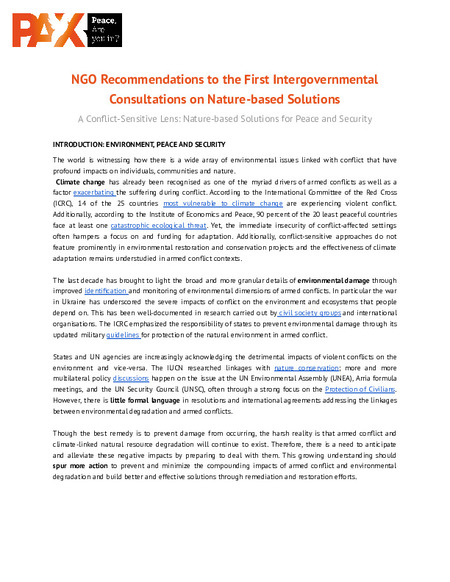| dc.contributor | Ecosystems Division | en_US |
| dc.contributor.author | PAX | en_US |
| dc.date.accessioned | 2023-05-05T11:42:52Z | |
| dc.date.available | 2023-05-05T11:42:52Z | |
| dc.date.issued | 2023-05 | |
| dc.identifier.uri | https://wedocs.unep.org/20.500.11822/42348 | |
| dc.description | The world is witnessing how there is a wide array of environmental issues linked with conflict that have profound impacts on individuals, communities and nature. Climate change has already been recognised as one of the myriad drivers of armed conflicts as well as a factor exacerbating the suffering during conflict. According to the International Committee of the Red Cross
(ICRC), 14 of the 25 countries most vulnerable to climate change are experiencing violent conflict. Additionally, according to the Institute of Economics and Peace, 90 percent of the 20 least peaceful countries face at least one catastrophic ecological threat. Yet, the immediate insecurity of conflict-affected settings often hampers a focus on and funding for adaptation. Additionally, conflict-sensitive approaches do not feature prominently in environmental restoration and conservation projects and the effectiveness of climate adaptation remains understudied in armed conflict contexts. | en_US |
| dc.format | pdf | en_US |
| dc.language | English | en_US |
| dc.rights | Public | en_US |
| dc.subject | nature-based solution | en_US |
| dc.title | NGO Recommendations to the First Intergovernmental Consultations on Nature-based Solutions: A Conflict-Sensitive Lens: Nature-based Solutions for Peace and Security | en_US |
| wd.identifier.sdg | SDG 15 - Life on Land | en_US |
| wd.identifier.sdg | SDG 16 - Peace, Justice and Strong Institutions | en_US |
| wd.identifier.sdg | SDG 17 - Partnerships for the Goals | en_US |
| wd.topics | Nature Action | en_US |
| wd.identifier.pagesnumber | 5 p. | en_US |


